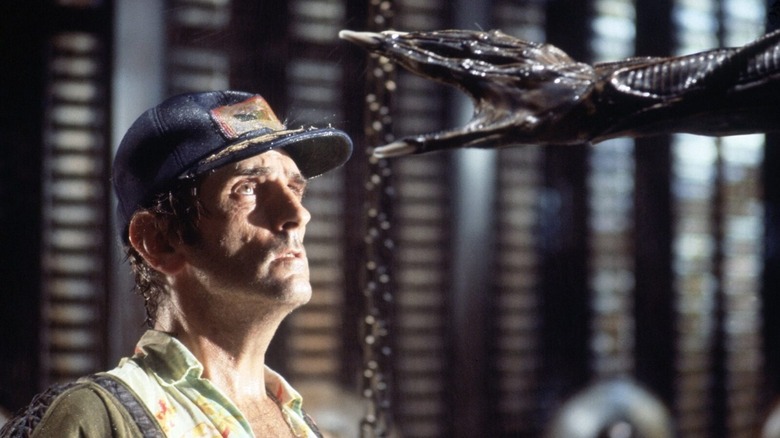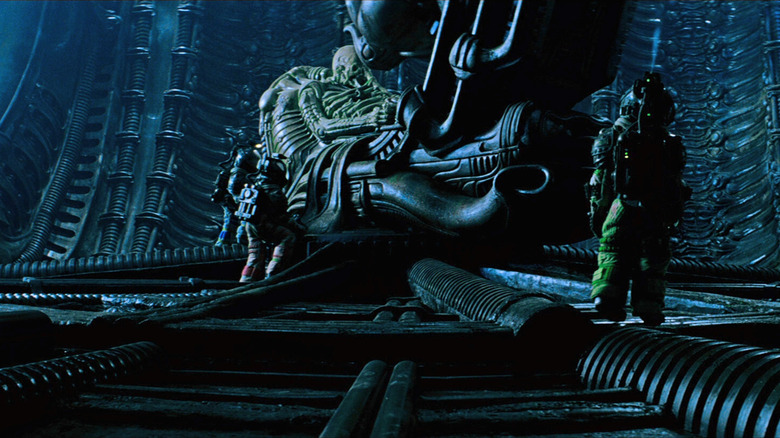H.R. Giger's Alien Designs Earned Him A Macabre Nickname On Set
The creature from Ridley Scott's 1979 horror sci-fi film "Alien" was inspired primarily by the 1976 painting "Necronomicon IV" by Swiss surrealist H.R. Giger. The subject of the painting rests in the middle of what appears to be a semi-metallic, semi-organic womb space of indeterminate function. The subject's lower half narrows and extends not into legs, but into an outsize phallus that stretches up over its head, searching for an organic aperture somewhere in its own cranium. The subject's ribs are visible. Its head, likewise, is decidedly phallic. On one end, it sports a monstrous face with fangs and large black eyes. The back end of its head tapers into something that is undoubtedly a glans. Intestinal tubes extend from the subject's back.
Like most of Giger's work, "Necronomicon IV" is nightmarish and unsettling. Giger worked in an aesthetic milieu that rested on a matrix where the organic and the mechanical, the dead and the sexual, were all kind of chummy. In addition to designing the central alien creature, Giger also constructed the infant version of it (the chestburster), and the lobster/bladder monster that attaches itself to its victims' faces (the facehugger). The alien craft that the humans explore in the film was also made entirely from Giger's paintings and designs. It's easy to take Giger's alien designs for granted now that the creature has appeared in video arcades and on t-shirts, but in 1979, the alien must have seemed, well, alien.
When Giger was working on "Alien," he was given a specialized studio where he could churn out creepy, sexual machine monsters to his heart's content. Giger was well known for his all-black ensemble, macabre interests, and creepy, Peter Lorre-like stare. Indeed, according to a 2014 profile in Express, Giger was nicknamed Count Dracula on set.
Count Dracula
In addition to his outfits and his interests, Giger also gained his Transylvanian nickname by the fact that he typically liked working late at night and was rarely seen during the daylight hours. The nickname was confirmed in a 2017 profile in Vanity Fair, that looked back over the production of "Alien" and its several sequels.
The Vanity Fair profile pointed out that Giger, while a brilliant and terrifying artist, was a little out of his element when it came to designing wearable suits for feature films. Actor Bolaji Badejo was to play the alien, and Giger needed to innovate ways to make an outfit that would look appropriately terrifying, but that could still be worm practically. Giger improvised for a lot of his designs, using on-hand objects like macaroni, car parts, and live oysters to achieve the appropriate look. Least exotic of the costume's elements were a pair of ordinary Converse All Stars that Giger merely painted black. Evidently, Ridley Scott wanted to push Giger's designs even further by including handfuls of live maggots underneath the translucent alien "skin." That idea was abandoned when the maggots proved to be difficult to wrangle.
It's well known among "Alien" fans that Scott had to fight the studio in order to incorporate Giger's designs into his film. Fox, it seems, felt that the paintings were just too weird. That, of course, was entirely the point. Notably, the filmmakers coated the monster in KY sexual lubricant in order to get it to glisten correctly. It seems that Giger's sexual designs were entirely appropos.

